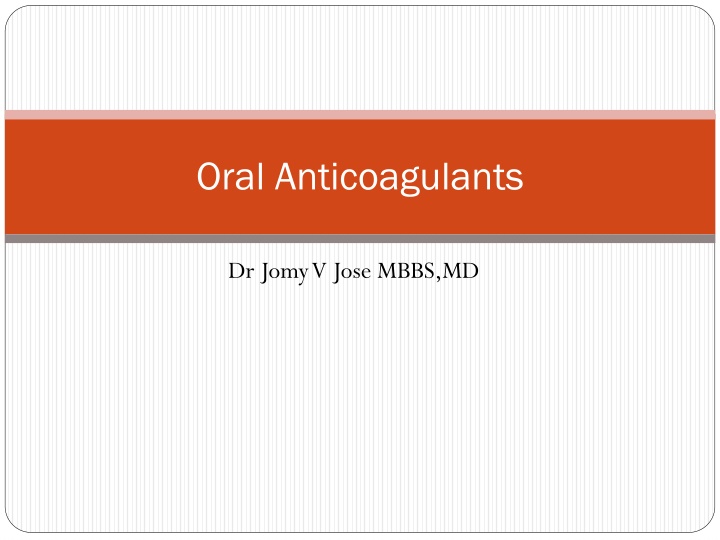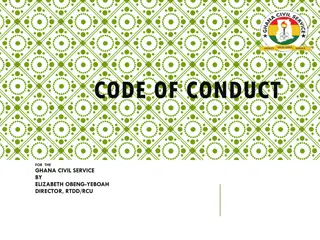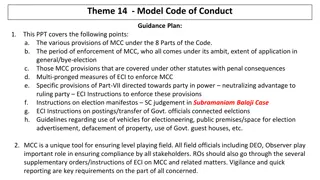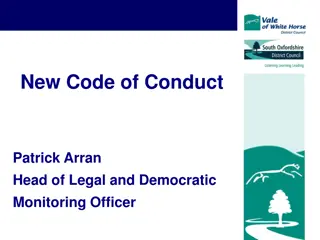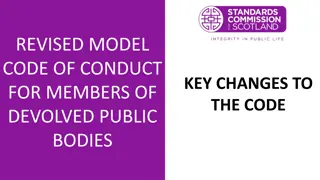Model Code of Conduct Learning Module for RO/AROs
This module covers the Model Code of Conduct (MCC) with its objectives, rationale, broad areas of application, and guidelines for officials, politicians, and stakeholders involved in elections. It emphasizes the importance of maintaining a fair and peaceful electoral environment to ensure credibility and prevent malpractices. Explore the MCC for insights on the dos and don'ts during the election process.
Download Presentation

Please find below an Image/Link to download the presentation.
The content on the website is provided AS IS for your information and personal use only. It may not be sold, licensed, or shared on other websites without obtaining consent from the author.If you encounter any issues during the download, it is possible that the publisher has removed the file from their server.
You are allowed to download the files provided on this website for personal or commercial use, subject to the condition that they are used lawfully. All files are the property of their respective owners.
The content on the website is provided AS IS for your information and personal use only. It may not be sold, licensed, or shared on other websites without obtaining consent from the author.
E N D
Presentation Transcript
Oral Anticoagulants Dr JomyV Jose MBBS,MD
Attributes Of The Ideal Anticoagulant Oral administration Rapid onset of action/rapid offset of action Wide therapeutic range Predictable therapeutic effect with fixed or weight-based dosing
No monitoring required (but the ability to monitor if desired) Well defined pharmacokinetics in presence of renal or hepatic disease Easily reversible Cost effective
Oral Anticoagulants Vitamin K Antagonists ( Coumarins ) : Warfarin, Acinocoumarol ( Acitrom ) AntiThrombinAgents : Dabigatran Anti XaAgents : Rivaroxaban, Apixaban, Edoxaban, Betrixaban, Darexaban (Discontinued from September 2011)
History of Oral Anticoagulation In 1921, Frank Schofield, a Canadian, observed that the cattle were hemorrhaging to death on procedures like dehorning. And that they were ingesting moldy fodder made from sweet clover. Scientists at the University of Wisconsin identified it later to be 4 hydroxycoumarin or Dicumarol.
Further research on Coumarins lead to the discovery of Warfarin. The name "warfarin" stems from the acronym WARF, for Wisconsin Alumni Research Foundation + the ending -arin indicating its link with coumarin. Warfarin was first registered for use as a rodenticide in the US in 1948. In 1951, when a US Army Inductee, unsuccessfully attempted suicide with multiple doses of warfarin as rodenticide and recovered fully after presenting to a hospital, and being treated with vitamin K (by then known as a specific antidote),studies began in the use of warfarin as a therapeutic anticoagulant.
Savior & Assassin Dwight Eisenhower Joseph Stalin
Warfarin Most Commonly used oral anticoagulant. It is a water soluble Vitamin K antagonist. It interferes with the synthesis of Vitamin K dependent clotting proteins which include Factors II, VII, IX , X. It also impairs synthesis of Vitamin K dependent anticoagulant proteins C and S.
Mechanism of Action of Warfarin All Vitamin K dependent clotting factors require a gamma carboxylation of their glutamic acid residues. This is catalyzed by reduced Vitamin K ( Vitamin K hydroxyquinone). The Vitamin K hydroxyquinone is produced from vitamin K epoxide by the enzyme Vitamin K epoxide reductase. Warfarin inhibits C1 subunit of Vitamin K Epoxide reductase ( VKORC1), thereby blocking the gamma carboxylation process.
Pharmacokinetics Warfarin is a racemic mixture of R and S Isomers. Rapid and almost complete absorption from gut. Blood levels peak after 90 minutes. Plasma half life of 36 to 42 hours. 97% is bound to albumin. Only rest is biologically active.
Pharmacokinetics Contd The S enantiomer is more active and is metabolized by CYP2C9. Variants are CYP2C9*2 and CYP2C9*3 The patients with one variant allele require 20% to 30% lower maintenance doses of warfarin. The R enantiomers are metabolized by CYP1A1, CYP1A2, CYP3A4
VKORC1 Variations Polymorphisms in VKORC1 can also influence anticoagulant response. Asians have maximum polymorphisms followed by whites and blacks. They are designated as A haplotype and non A haplotypes. Warfarin dose requirements for subjects heterozygous or homozygous for the A haplotype are 25% and 50% lower than the dose required for non A/non A haplotype.
Dosing of Warfarin Usually started at 5 mg Check INR daily till in therapeutic range. Then check thrice weekly for upto 2 weeks. Lower doses are prescribed for: 1. Patients with CYP2C9 and VKORC1 polymorphisms. 2. Older patients (Response to Warfarin increases with age) 3. Increased risk of bleeding (prior Aspirin use) 4. Patients of Asian descent. Bridging with Parenteral Anticoagulant in patients with established thrombosis or at high risk for thrombosis.
Dosing to be Reduced In: Congestive Heart Failure Liver Disease Renal Impairment Malnutrition Thyrotoxicosis Dosing to be Increased In: Myxoedema Green vegetables such as broccoli
Monitoring Warfarin Effect Prothrombin time Sensitive to reductions in levels of Prothrombin, Factor VII and X Method : Addition of Thromboplastin ( Tissue factor, Phospholipid and Calcium ) to citrated plasma. PT is time until clot formation. Problems with PT: Thromboplastins vary in their sensitivity to Vitamin K dependent clotting factors. So INR was introduced
INR Calculated as ratio of patients PT to Mean normal PT multiplied by International Sensitivity Index (ISI) ISI is an index of sensitivity of thromboplastin to reduction in levels of Vitamin K dependent factors. Highly sensitive Thromboplastin have a ISI of 1.0
Issues With INR Unreliable reporting of ISI by Thromboplastin manufacturers. Variations in reagent coagulometer combinations. Every lab must establish mean normal PT with each new batch of Thromboplastin reagent. To do this, PT of 20 healthy volunteers must be measured using same coagulometer used for patients.
How Often to Check INR In patients with stable Warfarin dosing INR should be checked every 3 weeks. More frequent INR testing will be required with addition of new drugs due to interactions. Self monitored and self guided therapy is better for educated patients.
Side Effects : Bleeding & Skin Necrosis Bleeding may be mild as epistaxis or hematuria May be severe as retroperitoneal or GI Bleed. Causes : 1. Higher than Therapeutic INR 2. Within Therapeutic INR but bleeding due to Peptic Ulcer or tumor.
Management of High INR & Bleeding Asymptomatic Patient : INR between 3.5 and 9 Warfarin is withheld till INR is in therapeutic range. If at high risk for bleeding: INR 4.9 to 9 2.5 mg of Vitamin K 1(Oral) INR > 9 2.5 to 5 mg of Vitamin K (Oral) Higher doses of Vitamin K (5 10 mg )may be used for rapid reversal of INR
Patients with Serious Bleeding Inj Vitamin K 10 mg slow IV infusion. Additional doses till INR is in Therapeutic range FFP to replace Vitamin K dependent clotting proteins. Prothrombin complex concenterates for life threatening bleeding or if patients cannot tolerate volume load.
In Prosthetic Valve Patients In patients with prosthetic valves Inj Vitamin K should be avoided because of the risk of valve thrombosis unless there is a major intracranial bleed.
Skin Necrosis Rare complication Occurs in patients with congenital or acquired deficiencies of Protein C and Protein S Occurs 2 to 5 days after initiation of therapy. Well demarcated erythematous lesions seen on buttocks, breasts, thighs or toes. Skin biopsy from the borders reveal thrombi in the microvasculature.
Mechanism of Skin Necrosis Initiation of warfarin therapy produces a fall in Protein C and Protein S levels first as their half lives are Hence a prothrombotic state prevails before the antithrombotic state takes effect. The procoagulant state triggers thrombosis in microvasculature of fatty tissues.
Treatment involves discontinuation of Warfarin and reversal with Vitamin K if needed. Alternative anticoagulant UFH or LMWH should be given to patients with thrombosis. Protein C concentrates in patients with Protein C deficiency FFP in patients with Protein S Deficiency.
Overlapping with Parenteral Anticoagulant Hence in patients with known Protein C or Protein S deficiency require overlapping treatment with a parenteral anticoagulant. In these patients Warfarin should be started at low doses. Parenteral anticoagulant should be continued until the INR is therapeutic for 2 to 3 days.
Contraindications Recent Stroke Hepatic Cirrhosis GI and Genitourinary Bleeding Points Uncontrolled Hypertension Renal impairment requires dose reduction. Eg. 25% dose reduction for a mean Cr Clearance of 47 ml/min If anticoagulation is necessary always assess the risk benefit ratio.
During Pregnancy Warfarin crosses the placenta but does not pass into breast milk There is risk for embryopathy causing nasal hypoplasia and stippled epiphyses especially in first trimester. CNS abnormalities occur with exposure to warfarin at any time during pregnancy. Also creates a anticoagulant effect in foetus which can cause intracranial hemorrhage during delivery.
Antiphospholipid Antibody Syndrome Usual Intensity Warfarin Therapy Versus High Intensity Warfarin therapy If the Lupus Anticoagulant prolongs the baseline INR then factor X levels can be used to monitor instead of INR.
Before Procedures No need to stop for procedures associated with low risk of bleeding. Eg: Dental Cleaning Dental Extraction Cataract Surgery Skin Biopsy To stop Warfarin 5 days before procedures with moderate or high risk for bleeding. Patients at high risk for thrombsis requires bridging with LMWH.
How Good Is Acenocumarol? Warfarin is employed more frequently than acenocoumarol because of its longer half-life (36 h), theoretically providing more stable anticoagulation, and avoiding factor VII fluctuations that potentially occur during acenocoumarol treatment (half-life 10 h).
Acenocoumarol: A Review of Anticoagulant Efficacy and Safety : JAPI Feb 2016
Overall Advantages Of Acenocumarol Rapid onset of action The effect lasts for 15-20 hours. Less dependence on CYP2C9 for metabolism compared to warfarin Better anticoagulation stability than warfarin Rapid reversal of anticoagulant action with relatively small amounts of vitamin K17
Switching The SPORTIF-III substudy has shown a good correlation between doses of warfarin and acenocoumarol. The dose ration of warfarin to acenocoumarol is 2.18 0.78. In another study the transition factor between acenocoumarol and warfarin is shown to be 1.85. The transition factor helps to calculate the maintenance dose when patient is required to be switch from acenocoumarol to warfarin.
What's Wrong With Warfarin? Narrow therapeutic range Slow onset of action Slow offset of action (long duration of action, long elimination half life) Multiple drug and dietary interactions Monitoring required to maintain in therapeutic range
Difficult to manage for invasive procedures Impaired quality of life for the patient Labor intensive for health care provider Under-use of therapy due to fear of adverse events and complexity of management
Efficacy is dependent upon infrastructure Time in therapeutic range (TTR) is associated with improved safety and efficacy TTR is improved with AC management programs TTR is greater in countries with more sophisticated health care infrastructure
Newer Direct Oral Anticoagulants Rapid onset of Action Half lives that permit once or twice daily action. Given in fixed doses without routine monitoring of coagulation. Antidotes now available for Induced bleeding.
Dabigatran Competitive direct thrombin inhibitor. Inhibits both free and clot bound thrombin as well as thrombin induced platelet aggregation. Substrate of P glycoprotein but no significant drug interactions. Half life is 12 17 hours. Bioavailability is 6.5% and 80% of drug is excreted by the kidneys.
Dosing For prevention of Stroke in Non Valvular AF dose is 150 mg BD If Creatinine clearance is 15 30 ml/min, dose is reduced to 75 mg BD. Now approved for VTE also: Patients should initially receive a minimum of 5 day course of parenteral anticoagulant before starting Dabigatran at 150 mg BD. Qualitative assessment of anticoagulant activity is by APTT. Quantitative assessment by Dilute Thrombin clotting time.
RE LY Study The RE-LY study demonstrated that compared to warfarin, high-dose dabigatran reduces stroke risk without increasing the risk of major bleeding among patients with atrial fibrillation. Published in 2009, the Randomized Evaluation of Long-Term Anticoagulation Therapy (RE-LY) trial was a non-inferiority study randomizing 18,000 patients with nonvalvular AF and a moderate-to-high risk of thromboembolic stroke to either high- or low-dose dabigatran or to warfarin.
